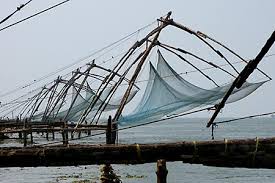The Santa Cruz Basilica, built in 1557 by the Portuguese, was used by the British in the 18th century as a warehouse. The Basilica, with its stunningly carved wooden panels and pulpit, was repaired in the early 20th century.

The Dutch palace at Mattancherry, though actually built by the Portuguese was presented to the ruler of Cochin in AD 1555. In 1663 the Dutch carried out some rebuilding and repairs in it. The main attractions of the palace are its wall murals depicting the scenes from the Ramayana.

Founded in 1503, this Portuguese fort is in ruins now. With its European legacy, stubborn self-absorption and its air of genteel decay, it is a place where history still stalks the lonely streets. One of the fascinating sights of the coast in Kochi is the cantilevered Chinese fishing nets brought here by traders belonging to Kublai Khan’s court.

At the heart the Jew Town near Mattancherry palace lies the synagogue of the white Jews. The synagogue has now become a fascinating mix of shops, warehouses and auction roomsn for spices. The Great Scrolls of the Old Testament; the Copper Plates recording the grants made by the Cochin rulers to the Jew are also displayed here.

St. Francis Church, the oldest European church in India, was built in the early 16th century. It was here that Vasco da Gama was first buried in 1562. It was only in 1578 that his remains were taken back by his son to Portugal.
